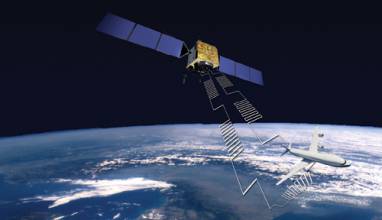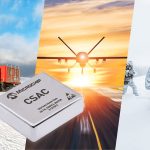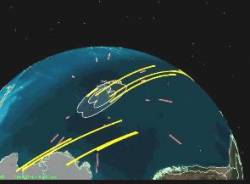Generally, a multipath signal in positioning is often considered an undesirable phenomenon that needs to be suppressed. A reflected GNSS signal is one kind of multipath, also known as a scattered signal. Usually, the reflected signal is regarded as an error source that deteriorates the positioning accuracy. But, in fact, these scattered signals can be used in many remote sensing applications.
Generally, a multipath signal in positioning is often considered an undesirable phenomenon that needs to be suppressed. A reflected GNSS signal is one kind of multipath, also known as a scattered signal. Usually, the reflected signal is regarded as an error source that deteriorates the positioning accuracy. But, in fact, these scattered signals can be used in many remote sensing applications.
This article will introduce the GNSS-reflection (GNSS-R) remote sensing concept and, taking GPS reflected signals as an example, demonstrate the characteristics of the these signals and our method for processing them to extract environmental data of interest. Then, we will describe our software-based receiving and processing system and tests performed for data collection over sea and grassland areas, presenting the related results.
GNSS-R Remote Sensing: The Concept
GNSS-reflection (GNSS-R) remote sensing is a new category of satellite navigation applications. Essentially, it entails a method of remote sensing that receives and processes microwave signals reflected from various surfaces to extract useful information about those surfaces.
In this process, the GNSS L-band satellite acts as the transmitter and an airplane or low earth orbit (LEO) satellite, as the receiving platforms. For altimetry applications, a GNSS-R receiver can also be placed on the land.
The advantages of GNSS-R remote sensing over satellite scatterometry and radar altimetry are as follows:
1) no additional transmitter;
2) plenty of signal sources, including GPS, Galileo, GLONASS, and Beidou/Compass;
3) use of spread-spectrum communication technology to enable the receiver to receive weak signals;
4) wide range of uses for such things as sea-wind retrieval, seawater salinity detection, ice-layer density measurement, humidity measurement of land, and detection of moving targets.
. . .
Characteristics of GPS Reflected Signal
Reflected GPS signals have a distinct signature or set of characteristics that are different from directly received signals. Some of the most important are:
1) Polarization. The GPS signal is right-hand circular polarized. When it is reflected by the surface, the signal might change into left-hand polarization. So, a left-hand circular polarization (LHCP) antenna is used to collect reflected data.
2) Code delay and Doppler shift. The reflected signal has to propagate an extra path segment compared with the direct one, thus causing an additional time delay. In this article, we use the equation 2h∙,sin-θ.= c∙τ to estimate the extra delay of the specular point.
In a former study, we considered the Dopplers of the direct and reflected signals as being the same, but, in fact, the Doppler changes after reflection. Taking this into account, first we use the Doppler of direct signal as that of the reflected one, and after calculation, we can get the true Doppler of the reflected signal.
3) Correlation. The correlation characteristic can be expressed by the integral function of correlation.
. . .
System Architecture
The GNSS-R processing system consists of a software-based GPS receiver with a pair of antennas (one right-hand polarized and the other left-hand polarized for reception at the L1 band) and dual front-ends, and a PC for signal processing. The front-end is used to down-convert the GPS signal to 4.6420 MHz and digitize it with two bits at a sampling frequency of 20.454 MHz.
. . .
Software and Algorithm Details
The GNSS-R software has the overall tasks of reading the collected data, processing it, and outputting the solutions. At the same time, it must also provide the users with status information about each channel and facilitate user control.
The software has three main tasks: parameter configuration, signal processing, and outputting results both in data files and on a graphic display.
. . .
Dynamic Test: Airborne Test Results
. . . an airplane was used to collect sea-reflected data. The RHCP and LHCP antennas were mounted on the top and belly of the plane, respectively, with the RHCP antenna zenith-oriented and the LHCP antenna nadir-oriented to collect signals reflected from the sea. The flying altitude was up to 5,000 meters with a maximum flying speed of 100 m/s.
. . .
According to the modeling and analyzing, we can obtain a measurement precision of 2 m/s for wind speed when the code interval is a half-chip and the Doppler interval is 250 Hertz.
Static Test Results: Grassland
We use grassland static test data to demonstrate the possibility of using our system in remote sensing of land areas.
Similar to the flight test, the RHCP and LHCP antennas were mounted on a shelf with the RHCP antenna oriented toward zenith and the LHCP antenna facing the grassland from which the signal reflections would arrive. After collecting data for a while, we poured water on the grassland to see if the reflected signal is sensitive to soil humidity.
. . .
Conclusions
This article introduced concepts about using GNSS-R in remote sensing and the related experiments we performed over sea and land using reflected GPS signals. We described our software-based receiving and processing system and displayed the processing results of the data collected in the two tests.
The results indicate that the reflected signal power is sensitive to the sea-wind and soil humidity, thus proving that our algorithm is correct and raising the possibility of using our software-based system in remote sensing.
Future work will include testing our system in other applications such as detecting the age of ice as well as improving the system accuracy for new applications.
For the complete story, including figures, graphs, and images, please download the PDF of the article, above.
Acknowledgments
The authors would like to thank those who helped us do our tests, in both sea and land experiments, in particular, Professor Ziwei Li, who works in the Institute of Remote Sensing and Application, Chinese Academy of Sciences, and Dr. Kebiao Mao, who works in The Chinese Academy of Agricultural Sciences.
Additional Resources
[1] Belmonte Rivas, M., and M. Martin-Neira, “Coherent GPS reflections from the Sea Surface,” IEEE Geoscience and Remote Sensing Letters, Vol. 3, No. 1, pp. 28–31, January 2006
[2] Esterhuizen, S., and D. Masters, D. Akos, and E. Vinande, “Experimental Characterization of Land-Reflected GPS Signals,” Proceedings of the ION GNSS 18th International Technical Meeting of the Satellite Division, 2005
[3] Garrison J. L ., and S. J. Katzberg and C. T. Howell,” Detection of Ocean Reflected GPS Signals : Theory and Experiment,” in Proceedings of the IEEE Southeastern ’97: Engineering the New Century[C], Blacksburg, Virginia, pp. 290-294, 1997
[4] Garrison, J. L., and A. Komjathy, V. U. Zavorotny, and S. J. Katzberg, “Wind speed measurement using forward scattered GPS signals,” IEEE Transactions on Geosciences and Remote Sensing, Vol. 40, No. 1, pp. 50–65, January 2002
[5] Gleason, S., and S. Hodgart, Y. P. Sun, C. Gommenginger, S. Mackin, M. Adjrad, and M. Unwin, “Detection and Processing of Bistatically Reflected GPS Signals from Low Earth Orbit for the Purpose of Ocean Remote Sensing,” IEEE Transactions on Geosciences and Remote Sensing, Vol. 43, No. 6, pp. 1229–1241, June 2005
[6] Grant, M. S., and S. T. Acton and S. J. Katzberg, “Terrain Moisture Classification Using GPS Surface-Reflected Signals,” IEEE Geoscience and Remote Sensing Letters, Vol. 4, No. 1, pp. 41–45, January 2007
[7] Lowe, S. T., and P. Kroger, G. Franklin, J. L. LaBrecque, J. Lerma, M. Lough, M.R. Marcin, R. J. Muellerschoen, D. Spitzmesser, and L. E. Young, “A Delay/Doppler-Mapping Receiver System for GPS-Reflection Remote Sensing,” IEEE Transactions on Geosciences and Remote Sensing, Vol. 40, No. 5, pp. 1150–1163, May 2002
[8] Yang, D. K., and Y. Q. Zhang, Y. Lu, and Q. S. Zhang, “GPS Reflections for Sea Surface Wind Speed Measurement,” IEEE Geoscience and Remote Sensing Letters, Vol. 5, No. 4, pp. 569–572, October 2008
[9] Zavorotny, V. U., and A. G. Voronovich and S. J. Katzberg, “Extraction of Sea State and Wind Speed from Reflected GPS signals: Modeling and Aircraft Measurements,” in Proceedings IGARSS 2000, vol. 4, pp. 1507–1509, July 2000






